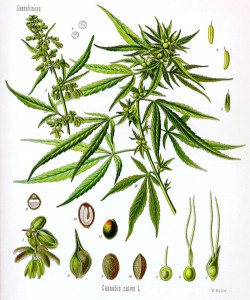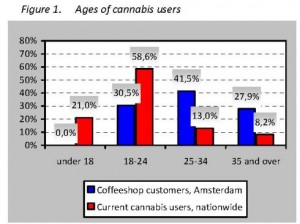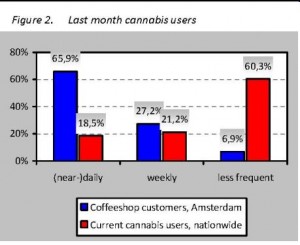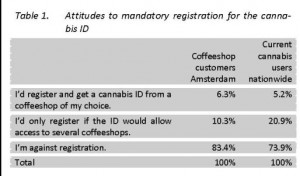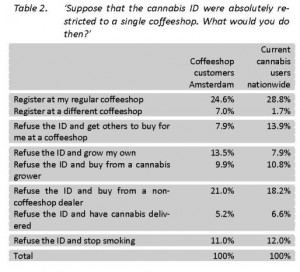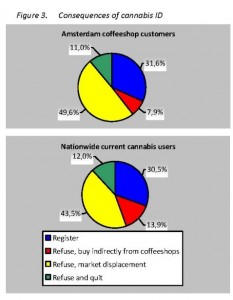The Return of the Underground Retail Cannabis Market?
Attitudes of Dutch coffeeshop owners and cannabis users to the proposed ‘cannabis ID’ and the consequences they expect.
ABSTRACT
The sale of cannabis to persons aged 18 or older is permitted in the Netherlands under certain conditions in commercial establishments called coffeeshops. The present Dutch government has proposed that access to coffeeshops be restricted to persons holding a cannabis ID, a mandatory membership card known colloquially as a ‘weed pass’ (wietpas). Recent interviews with 66 Amsterdam coffeeshop owners reveal that they expect mainly detrimental effects from the proposed measure. In particular, they predict customer resistance to compulsory registration, the discriminatory exclusion of tourists and other non-members, and a resurgence of cannabis street dealing. Two surveys of cannabis users (in a local sample of 1214 Amsterdam coffeeshop customers and a nationwide sample of 1049 last-month users) confirmed that many, but not all, users would oppose registration. The majority of respondents intended to look for other suppliers or to grow their own marijuana if the cannabis ID becomes law. Surprisingly, about one in ten said they would stop smoking cannabis.
Introduction
Wide differences exist between Western countries in terms of national cannabis policies (MacCoun & Reuter, 2002; Decorte et al., 2011; EMCDDA, 2010). In the Netherlands, cannabis is officially an illicit drug, but the retail cannabis market has uniquely been decriminalised by measures providing for the legal toleration of hashish and marijuana sales to consumers via commercial venues known as coffeeshops (Box I). Most coffeeshops are cafés, but some function more as take-away shops, where cannabis can be bought but not consumed.
Box I – Coffeeshops and Dutch cannabis legislation
The first Dutch drug law dates from nearly a century ago: the Opium Act of 1919. The import and export of cannabis was added to the act in 1928; possession, manufacture and sale became offences in 1953. The statutory decriminalisation of cannabis took place in 1976. De facto decriminalisation had set in earlier, as local authorities began tolerating ‘house dealers’ in youth centres in the early 1970s. Experiments with this approach were formalised in the revised Opium Act of 1976. It distinguishes between Schedule I drugs (such as heroin and cocaine), seen as posing an ‘unacceptable’ risk, and Schedule II substances (mainly cannabis products), which carry lower official penalties.
The legal basis for coffeeshops had been laid by the Dutch government when it decriminalised cannabis in 1976. Latitude was created for sales of small amounts of cannabis to consumers (though selling remained officially illegal), on the crucial condition that the sale of cannabis be strictly separated from markets for hard drugs. Coffeeshops were one result of the deriminalisation process, albeit not exactly what policymakers had envisaged. A series of later court decisions effectively subsumed coffeeshops under existing legislation.
Since the 1960s, the Dutch retail market for cannabis has gone through different stages, originating in the sale of cannabis in underground markets. During the 1970s, sales shifted to tolerated ‘house dealers’ in youth clubs and nightspots, and coffeeshops took over the market in the 1980s (Jansen, 1991; Korf, 2002). The number of coffeeshops expanded dramatically during the 1980s, peaking in the mid-1990s at about 1,500 throughout the country (Bieleman & Goeree, 2001). A new phase then ensued, and the number began to diminish. Although coffeeshops must meet nationally defined criteria (Box II), policy modifications in 1996 gave local governments the right to decide whether or not to authorise coffeeshops within their jurisdictions; they may now close down or ban coffeeshops, even if these do not violate national criteria. In the wake of that policy change, many municipalities decided to close down all existing coffeeshops or limit their number. By 1999, the number of coffeeshops in the country had almost halved to 846. The downward trend continued, and the most recent national figures reported 666 coffeeshops by the end of 2009; 340 (77.1%) of the then 441 municipalities had decided not to allow any coffeeshops at all (Bieleman & Nijkamp, 2010).
Box II – National guidelines for coffeeshops
Official national Guidelines for Investigation and Prosecution came into force in 1979. They stipulated that the retail sale of cannabis to consumers may be tolerated, provided that certain criteria were met: no advertising, no hard drugs, no nuisance and no young clientele (later defined in 1996 as under age 18). More recently, additional criteria were formulated: no large quantities (maximum of 5 grams of cannabis per client per transaction and per day; maximum of 500 grams of cannabis stock in coffeeshop at any one time); and no alcohol served on premises.
The newest criterion specifies minimum distances between coffeeshops and secondary schools. According to most current plans being discussed by the government, a nationwide minimum distance of 350 meters would be set, but the Parliament is still deliberating on this and other deterrent measures.
In recent years, the Dutch political agenda on coffeeshop policy has predominantly focused on issues involving the wholesale supply chains to coffeeshops (the ‘back door problem’; Korf, 2011) and on the pull exercised by coffeeshops in border areas on customers from neighbouring countries, which is a source of considerable nuisance. In an attempt to combat the latter problem, the national government has proposed mandatory club membership for coffeeshop customers. This would make all coffeeshops into private clubs accessible only to residents of the Netherlands aged 18 or older who have been issued a cannabis ID, a membership card meanwhile colloquially known as the ‘weed pass’. Persons wishing to patronise coffeeshops must register to do so, and this is intended to have a strong deterrent effect on cannabis users living in neighbouring countries (notably Germany, Belgium and France). Perhaps the most crucial question in terms of legal feasibility is whether the Netherlands would be entitled under EU treaties to exclude other EU citizens in such a way.
The future will tell whether and how the cannabis ID will be introduced. If that should indeed happen, though, what consequences could then be expected for the retail cannabis market? The purpose of this article is to gauge the breadth of support for the cannabis ID among the immediate stakeholders in that market and to assess the potential consequences of the measure.
Amsterdam coffeeshop proprietors and their opinions on the cannabis ID
One third of all Dutch coffeeshops are located in Amsterdam, though only 5% of the country’s population lives there. About half of the 222 Amsterdam coffeeshops are found in the city centre, and many attract a substantial number of tourists. Unlike the situation in border towns, the foreign visitors do not come to Amsterdam primarily for coffeeshops. Most stay in the city for several days at least, and coffeeshop customers cause little or no nuisance. Coffeeshops outside the city centre cater mainly to local residents.
In view of the large number of coffeeshops in Amsterdam, whether or not frequented by tourists, the introduction of a cannabis ID could have relatively drastic consequences for such businesses. In the spring of 2011, we therefore conducted face-to-face interviews with 66 coffeeshop owners (or their managers). Their coffeeshops were found all over the city, both in the inner city and in more outlying districts; the sample reliably reflected the variation in Amsterdam coffeeshops in terms of size, number of customers and customer profiles.
Almost nine in ten of the interviewed owners expected the introduction of IDs to have exclusively negative consequences. The rest likewise foresaw mainly detrimental effects but did cite some advantages, such as guaranteed custom. ‘Your regular customers will have to register at your coffeeshop and will be allowed to buy their grass or hash only from you. That ensures customer loyalty.’ Virtually all respondents listed a range of drawbacks to the proposed system, falling roughly into three categories:
1. The registration and privacy problem
To many coffeeshop owners, it was patently self-evident that the registration system would spark disquiet amongst customers. ‘People don’t want to be registered for anything, let alone as potheads.’ One proprietor with many doctors and lawyers in his clientele pointed to the detriment they might suffer if they were registered as cannabis users. ‘Nobody needs to know how much and how often they smoke. Why would they?’ A question many owners were asking is what would be done with the stored data. An additional drawback in this category is the constriction of customers’ freedom of choice if they can register for only one coffeeshop.
2. Exclusion of foreign tourists and other non-members
Introduction of cannabis IDs would, according to proprietors, ‘exclude tourists from participation’, a prospect that caused considerable indignation. ‘It’s pure discrimination!’ and ‘Tourists can now buy safe, good-quality cannabis. Who in the hell would want to change that?’ Since tourism is a mainstay of the broader Amsterdam economy, the measure might also deal a hard blow to the municipal coffers. Not only foreign tourists, but also shoppers and visiting relatives from other Dutch towns would be prohibited from buying cannabis in Amsterdam. People who only smoke cannabis occasionally would also be stigmatised; even if you only smoke once a year, you would still have to register as a pot smoker.
3. Revival of street dealing
If tourists are banned from coffeeshops, proprietors said, the lively cannabis street trade of decades ago will resurface. Dutch customers who oppose registration will also seek their sustenance elsewhere, and that could well be from street dealers. The illegal market would generate crime and nuisance. Some also foresaw an increase in under-the-counter sales. ‘Your customers will still be coming in to buy their joints from you, whether you’re a coffeeshop, a pub or a snack bar.’ A final objection was an expected black-market trade in cannabis IDs, which would provide tourists and minors with a good alternative means of procuring their drugs.
Two surveys of cannabis users
Directly after our interviews with the coffeeshop owners in the spring of 2011, we conducted a site survey of customers in 59 Amsterdam coffeeshops, similarly dispersed across the city. The 1214 respondents did not constitute a representative sample of all coffeeshop customers in the city. In our recruitment strategy, the more frequent customers had a much higher probability of being interviewed than occasional customers. The sample did provide a reasonably reliable picture of the clientele present in coffeeshops on peak days and at peak hours. By concentrating on peak days (Thursdays, Fridays and Saturdays) and peak hours (3 to 9 pm), we compensated somewhat for the overrepresentation of frequent or daily customers in the sample. The survey was further confined to customers who spoke sufficient Dutch, which in practice mainly excluded foreign tourists.
Subsequently, from May to mid-July 2011, we conducted a nationwide online survey entitled Sex & Drugs via the website of BNN, a Dutch public broadcasting organisation that targets mainly adolescents and young adults. A total of 3257 persons completed the questionnaire, of whom 1049 had smoked cannabis in the past month (current users). Questions on the cannabis ID were submitted to the latter group only.
The minimum age for entering a coffeeshop is 18. In our Amsterdam coffeeshop survey, the average age in the sample was 32.4, with a peak in the 25-34 age category. In the online survey, not confined to coffeeshop customers, the average age of the current cannabis users was distinctly lower (23.4), peaking in the 18-24 category (figure 1).
The samples also differed in gender terms. A small minority of respondents in the coffeeshop survey were female (13.6%), whilst more than half (52.5%) of the current cannabis users nationwide were female.[i]
The Amsterdam coffeeshop customers we polled were also far more likely than the online respondents to be daily or near-daily cannabis users (figure 2).
Willingness to register for the cannabis ID
Both in the interviews with Amsterdam coffeeshop customers and in the online nationwide survey, we asked two questions about the proposed cannabis ID. The first was: ‘Imagine that a mandatory cannabis ID has just been introduced. You would then get registered at one coffeeshop and you would only be allowed into that coffeeshop. What would you think about that?’ Respondents could choose from three answer options (see table 1).
Despite the large differences between the two surveys in terms of age, gender distribution and frequency of cannabis use, only a tiny minority in each survey indicated a willingness to register and obtain a cannabis ID from the coffeeshop of their choice. Slightly more respondents said they would register if the cannabis ID gave access to several coffeeshops of their choice. Large majorities came out against registration in the online survey and, still more strongly, in the Amsterdam customers’ survey.[ii]
Perceived consequences of the cannabis ID
We next asked both samples: ‘Suppose that the cannabis ID were absolutely restricted to a single coffeeshop. What would you do then?’ Out of eight answer options, respondents could choose the one that suited them best (see table 2).
Table 2. – Suppose that the cannabis ID were absolutely restricted to a single coffeeshop. What would you do then?
Notwithstanding small variations between the surveys on various answers, similar patterns emerged (figure 3).[iii]
The proportion that would now register despite earlier objections grew to just under one third, most of whom would opt for their regular coffeeshop. In contrast to them, a markedly smaller but noteworthy proportion (11%-12%) reported they would shun the ID and stop smoking cannabis should they be obliged to register with and patronise a single coffeeshop only.
The majority reported that they would refuse the cannabis ID and then obtain their cannabis from other sources outside the coffeeshops. Three types of intentions were distinguishable:
Delegating. These respondents would get someone else to go to the coffeeshop for them. Current cannabis users in the nationwide survey were about twice as likely to choose this ‘indirect supply from coffeeshops’ option as compared to the Amsterdam coffeeshop customers. The difference could be traced mainly to the non-daily users.
Market displacement towards home growing. Nearly one quarter of the Amsterdam coffeeshop customers and one fifth of the current users nationwide said they would grow their own marijuana or buy it from a grower.
Market displacement towards other drug dealers. Over one quarter of respondents in both surveys said they would buy marijuana or hashish in a setting other than coffeeshops (e.g. street settings), from a different source (e.g. a home-based dealer), or through home delivery.
Conclusions and discussion
Amsterdam coffeeshop owners foresee almost no advantages from the introduction of the proposed cannabis ID. They predict that it will compromise the privacy of customers (many of whom are expected to shun registration); that it will impose a discriminatory ban on foreign tourists and other non-residents of the city, which could eventually also have a significant impact on the local economy; and that it will trigger a revival of street dealing in soft drugs, thus weakening the current separation of markets and making hard drugs more easily accessible to cannabis users.
The coffeeshop owners’ prediction that many customers will resist the cannabis ID is confirmed by our survey of Amsterdam coffeeshop customers. When informed about the proposed ID, the vast majority of customers spontaneously answered that they would oppose registering to qualify for an ID, as did a substantial majority of current cannabis users throughout the country. Resistance slackened somewhat when respondents were presented with a strict scenario of compulsory registration; almost one in three said they would then register after all. The majority of refusers would opt for growing their own marijuana or buying directly from a cannabis grower, or for purchasing cannabis through other channels than coffeeshops, such as drugs delivery services, home-based dealers or street dealers. Some refusers would get others to go to coffeeshops for them, thus still indirectly patronising the coffeeshops.
Notably, over ten per cent of respondents said they would stop smoking cannabis if the ID becomes law. Coffeeshop owners did not appear to expect any such development, and it is questionable whether those who say they would quit would actually do so. After all, intention is no guarantee for real behavioural change (Ajzen, 1985; Bamberg et al., 2003; Bandura, 1986; De Vries et al., 1998; Prochaska & DiClemente, 1982). Similar uncertainty applies to the prediction – made by coffeeshop owners, customers and surveyed current users alike – that the cannabis supply would shift to the streets and other locations and to home grow.
A limitation to this study is that the surveys were based on non-normative convenience samples. Some caution is therefore warranted as to the generalisability of the reported percentages. That said, there were striking similarities between the two samples both in attitudes to mandatory registration and in the perceived consequences of the cannabis ID, despite differences between the surveys in terms of method (site versus online survey), geographical scope (Amsterdam versus nationwide) and respondent characteristics (age, gender, frequency of cannabis use). Displacement of the retail cannabis market to non-coffeeshop settings, as indicated by both surveys, therefore seems a very real possibility, although it is unclear to what extent and in what ways that might happen.
All in all, our surveys of cannabis users provide empirical evidence in support of fears, as expressed by opponents of the cannabis ID, that it will lead to a resurgence of the underground retail cannabis market and the accompanying crime and nuisance. Proponents of the ID will undoubtedly be keen to argue in the political debate that introducing the ID will help curb the use of cannabis.
Notes
[i] Women were somewhat overrepresented in the total Sex & Drugs sample (55.1% female versus 43.6% male). Males in that sample were slightly more likely to have consumed cannabis in the past month (34.3% versus 30.9%, p < .05).
[ii] Some of the current cannabis users in the nationwide online survey were under 18 and hence too young to enter a coffeeshop. Amongst respondents 18 and older, the percentages were similar to those in the overall sample (6.0% and 22.7% would register and 71.8% would refuse; percentages for under-18s were 2.3%, 14.8% and 82.9%.
[iii] Confining ourselves to the nationwide respondents aged 18 or older, virtually the same pattern emerges as in the overall sample: 32.1% would register, 12.9% would refuse and get others to buy for them in a coffeeshop, 43.5% would opt for a non-coffeeshop supplier (market displacement) and 11.5% would refuse and give up smoking (percentages for under-18s were 25.0%, 18.1%, 43.1% en 13.9%.
REFERENCES
Ajzen, I. (1985). From intentions to actions: A theory of planned behavior. In J. Kuhl & J. Beckmann (eds), Action-Control: From Cognition to Behavior (pp 11-39). Heidelberg: Springer.
Bamberg, S., Ajzen, I., & Schmidt, P. (2003). Choice of travel mode in the theory of planned behavior: The role of past behavior, habit and reasoned action. Basic and Applied Social Psychology, 25(3), 175-187.
Bandura, A. (1986). Social Foundations of Thought and Action: A Social Cognitive Theory. Englewood Cliffs: Prentice Hall.
Bieleman, B., & Goeree, P. (2001). Coffeeshops in Nederland. Aantallen en gemeentelijk beleid in 2000. Groningen: Intra-val.
Bieleman, B., & Nijkamp, R. (2010). Coffeeshops in Nederland 2009.
Aantallen coffeeshops en gemeentelijk beleid 1999-2009. Groningen: Intraval.
Decorte, T., Potter, G.R., & Bouchard, M. (eds) (2011). World Wide Weed. Global Trends in Cannabis Cultivation and Its Control. Farnham: Ashgate.
De Vries, H., Dijkstra, M., & Kuhlman, P. (1988). Self-efficacy: the third factor besides attitude and subjective norm as a predictor of behavioural intentions. Health Education, 3, 273-282.
EMCDDA (2010). Annual Report 2010: The State of the Drugs Problem in Europe. Lisbon: European Monitoring Centre for Drugs and Drug Addiction (EMCDDA).
Jansen, A.C.M. (1991). Cannabis in Amsterdam: A Geography of Hashish and Marihuana. Muiderberg: Coutinho.
Korf, D. J. (2002). Dutch coffee shops and trends in cannabis use. Addictive Behaviors, 27(6): 851-866.
Korf, D.J. (2011). Marihuana behind and beyond coffeeshops. In T. Decorte, G.R. Potter & M. Bouchard, (eds), World Wide Weed. Global Trends in Cannabis Cultivation and Its Control. Farnham: Ashgate, pp. 181-195.
MacCoun, R., & Reuter, P. (2002). The varieties of drug control at the dawn of the twenty-first century. The Annals of the American Academy of Political and Social Science, 582(4): 7-19.
Prochaska, J.O., & DiClemente, C.C. (1982). Transtheoretical therapy: Toward a more integrative model of change. Psychotherapy: Theory, Research and Practice, 19, 276-288.
Published in The Bonger International Bulletin – September 2011
The Bonger International Bulletin reports and discusses findings from research studies conducted at the Bonger Institute of Criminology.
Willem Adriaan Bonger (1876-1940) was one of the founding fathers of Dutch criminology and the first professor of sociology and criminology in the Netherlands. He argued that crime is social in origin and is causally linked to economic and social conditions.
Bonger Institute of Criminology
Faculty of Law, University of Amsterdam
